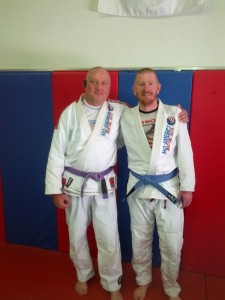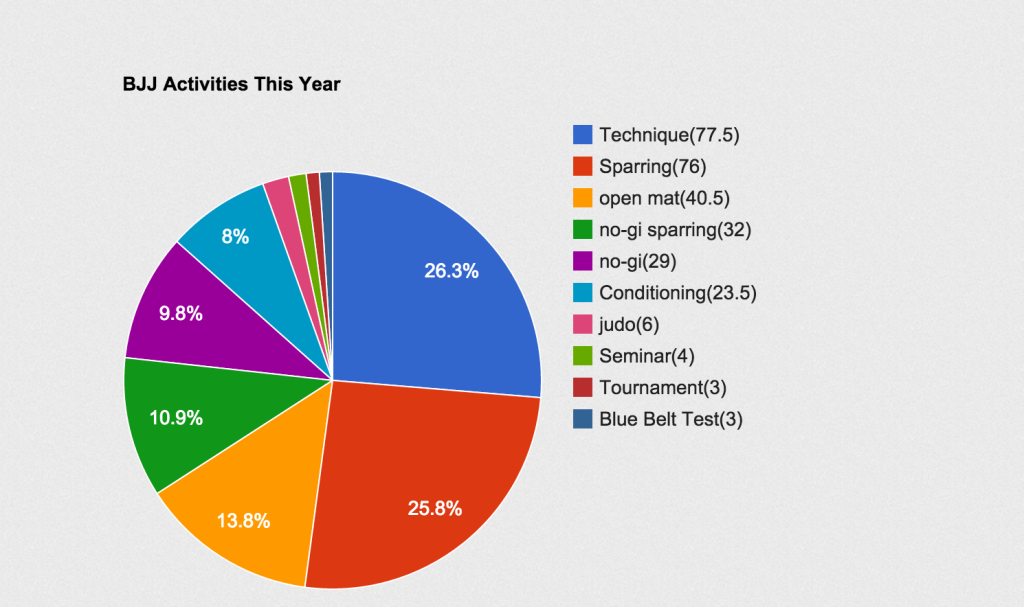On August 6, 2012 I walked into Mid-America Martial Arts and started my first Brazilian Jiu Jitsu class that night. I was totally out of my element. There were legit pro fighters training for an upcoming bout. There was a constant thud as the Muay Thai guys were hitting pads. I was wearing a big, heavy gi, with no idea how to tie my belt. I was walked over to the intro class where I was greeted by a guy with skull tattoos and shaved head. Was this really something I wanted to do? Was I crazy? Was I too old to be starting at almost 35? This was a far cry from the computer screen I was used to sitting in front of.
I knew next to nothing of BJJ at the time. I knew it was used in MMA, but I had no interest in being a fighter, something I made sure Aaron (owner of MAMAs) knew when I talked to him on the phone. It just looked “fun”. That’s a sentiment that to this day my wife can’t grasp.
I knew that since it was a martial art, it most likely had belts. I knew I’d start at white and I knew there were brown and black belts, but that’s all I knew. I didn’t know how to progress through the belts, or what belt came next. I didn’t know how long I’d need to train to advance. I was pretty much a tablua rasa.
Shortly after starting the intro class there was one night that nobody else showed up, so it was just the instructor and I. He told me about the belts, told me it took him quite some time to get to blue, told me he started at 40, told me all sorts of things that made me love BJJ more, and in particular, made me proud to be studying under Rodrigo Vaghi.
It wasn’t long before I started hearing about the “blue belt test.” Not as something that I would need to worry about any time soon, but when people get close to testing, the stories come out. I found an forum post online by one of Vaghi’s guys in St. Louis that talked about how totally exhausted he was afterwards.
To be honest, at the same time it was terrifying and exciting. Terrifying to think about being pushed to that physical level. Exciting at the thought of testing my limits. That’s part of what I was here for. No more couch potato. If I mean that, then something like that test is what I signed up for.
I still held out hope that the colored belts were just trolling the white belts that were getting ready for their blue belt test, until I saw the “after” pictures of one test. The new blues looked absolutely exhausted.
I know very little about the test. I know it’s 3 hours long. I know the last hour is all sparring with the colored belts. I know that there’ll be some bear crawls. That’s about it.
I also know that I was invited around July of this year to take the test. I’m actually getting ready to go do that in about 30 minutes. I won’t post this until afterwards, because I’d hate to jinx myself.
I’ll say this, though. For the past month I’ve been waiting for this day. This past week has been like the week before Christmas for a little kid. Wednesday, Thursday and Friday, I woke up with the thought “Is it time to go yet?” At work I’d think things like “48 hours from right now.” Last night I set an alarm for 7am, so that I could get up slowly, relaxed and eat breakfast. If I have to rush out the door, I don’t eat. Turns out I didn’t need that alarm. I woke up at 3:30, 4:15, 5 and finally got out of bed at 6am.
I’ve taken this morning to watch a little Netflix (Ken Burns’ Baseball), read some Reddit, and now I’m listening to Tool (just for Marty, who I know loves it so much.)
I did my last training for the week Tuesday night. Afterwards, I went through my tracking application and summed up what being a white belt has meant for me in terms of hours on the mat. A lot of people like to get wrapped up in “How long until I get my _____ belt.” Some people say “You should be a blue in 1 to 2 years.” I don’t know if any of that is true. I think it is highly dependent on you and your training schedule. Here’s what I’ve done over the past 26 months:
Gi Technique: 227 hours (Probably about another 40 hours here, but I didn’t start tracking until January of 2013)
Gi Sparring: 164 hours
No-Gi Technique: 39 hours
No-Gi Sparring: 34 hours
Open Mat: 48 hours
Seminar: 14 hours
Total: 526 hours.
I also did 9 tournaments. Of those, 3 were in house tournaments.
I could not have done this without the amazing people at Mid-America. Some of whom are no doubt reading this. In fact, there are too many to mention by name. It really was a team effort, and I’m thankful for all of them.
Oh, and the guy with the skull tattoos? Super nice guy, that absolutely destroys me.
Here’s a picture of Scott & I. He doesn’t have skull tattoos, but he’s one of the coaches that did the intro class and has been a lot of help. 


